National Parks in New York
Visiting National Parks is not the first thing that comes to mind when most people think of New York. You may have heard of Niagara Falls, the Statue of Liberty, and Ellis Island.
But New York State is actually home to more National Monuments, Historic Sites, and Heritage Areas than a lot of other states combined!
In this article we’re going to cover some of the top destinations affiliated with the National Park Service; and some can’t-miss historic buildings to round out your trip.
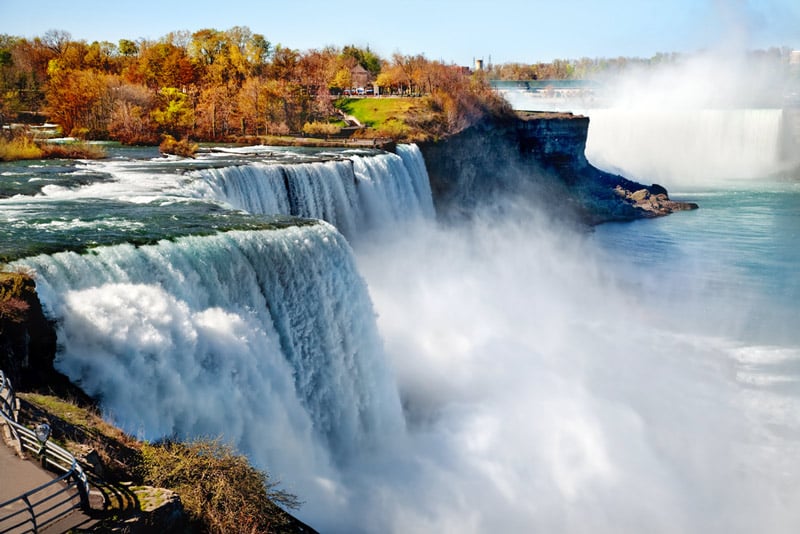
List of New York national Parks
New York is home to over 20 National Historic sites and National Monuments; many of which are located right in the city.
12 National Parks are located in New York Harbor (look for the asterisks*), so you don’t have to travel far from the city to experience a piece of history.
National Monuments & Historic Sites In New York
- African Burial Ground National Monument*
- Castle Clinton National Monument*
- Eleanor Roosevelt National Historic Site
- Statue of Liberty National Monument & Ellis Island*
- Federal Hall National Memorial*
- Fort Stanwix National Monument
- General Grant National Memorial*
- Governors Island National Monument*
- Hamilton Grange National Memorial*
- Harriet Tubman National Historic Park
- Home of Franklin D Roosevelt National Historic Site
- Lower East Side Tenement Museum National Historic Site
- Martin Van Buren National Historic Site
- Sagamore Hill National Historic Site
- Saint Paul’s Church National Historic Site*
- Stonewall National Monument*
- Theodore Roosevelt Birthplace National Historic Site*
- Theodore Roosevelt Inaugural National Historic Site
- Thomas Cole National Historic Site
- Vanderbilt Mansion National Historic Site
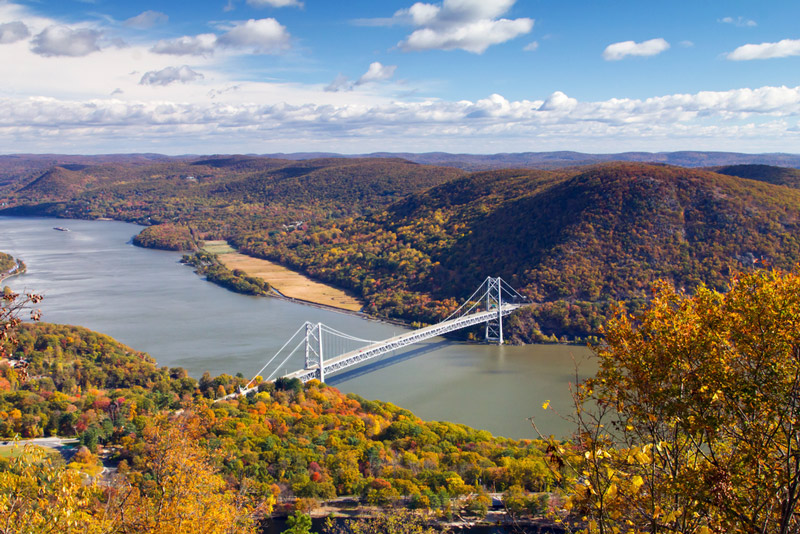
National Heritage Areas & Historic Parks In New York
- Hudson River Valley National Heritage Area
- Niagara Falls National Heritage Area
- Saratoga National Historic Park
- Women’s Rights National Historic Park
National Scenic & Historic Trails In New York
- Appalachian National Scenic Trail
- Captain John Smith Chesapeake National Historic Trail
- North Country National Scenic Trail
- Washington-Rochambeau Revolutionary Route National Historic Trail
National Recreation Areas, Watersheds, Seashores, and Corridors
- Chesapeake Bay Watershed
- Erie Canalway National Heritage Corridor
- Fire Island National Seashore
- Gateway National Recreation Area*
- Upper Delaware Scenic and Recreational River
The Best National Parks In New York
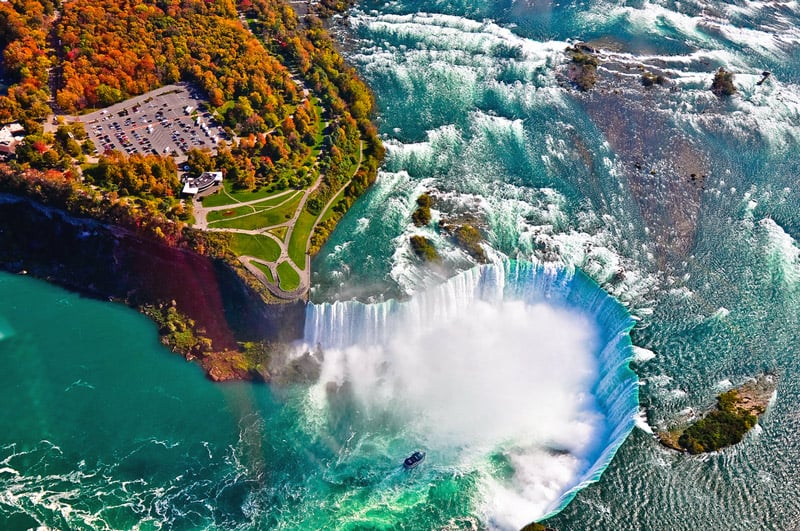
Niagara Falls National Heritage Area
The Niagara Falls National Heritage Area incorporates the city of Niagara, four towns and villages, and a variety of state parks along the Niagara River.
In the area, you’ll find a variety of privately operated tour companies, lots of restaurants, and plenty of gift shops.
This isn’t the type of park that makes it easy to get away from the crowds, but there are plenty of places to walk around outside and view the famous waterfalls from a variety of angles.
The Discover Niagara Shuttle is operated through the National Park Service and makes 15 stops throughout Niagara. This is a free, hop-on and hop-off shuttle which makes it easy to get around from Old Fort Niagara to the USA Official Visitor Center.
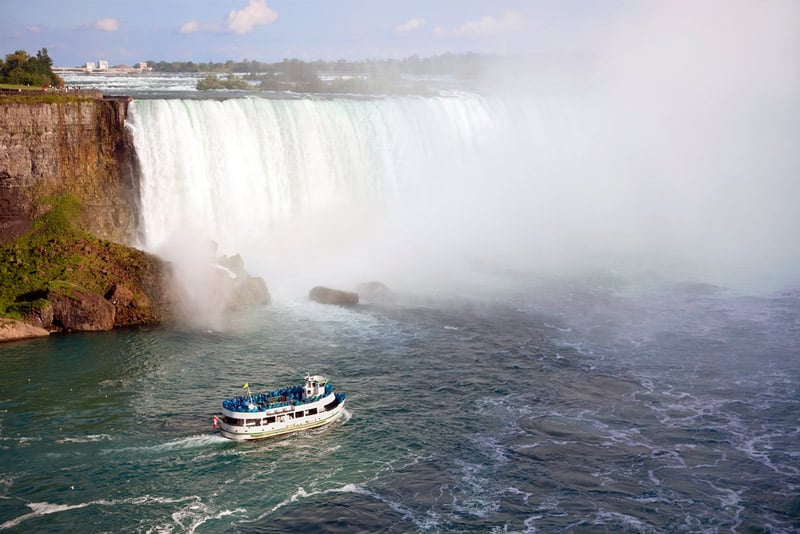
Take a ride on Maid of the Mist
One of the most famous attractions at Niagara Falls is the Maid of the Mist. This is a tour boat that begins at observation tower and floats from American Falls to the Basin of Horseshoe Falls.
Be prepared to get wet! Not only will you feel the mist from the 167 foot waterfall, but you can walk your way up “Cave of the Winds” as well, soaking in the mist along the rocks.
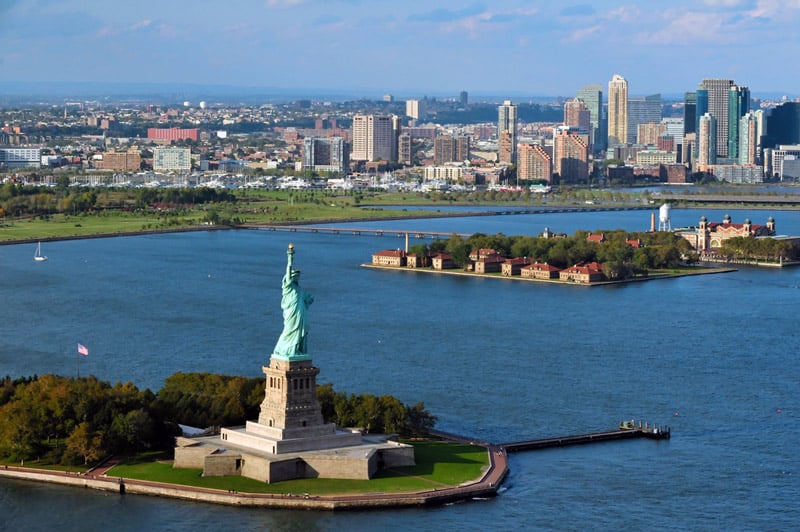
Statue of Liberty National Monument
The Statue of Liberty is one of America’s most iconic landlords and an important historical monument. Standing tall in New York, this statue symbolizes the freedom and democracy of Americans. It was a gift from the French people after the revolutionary war demonstrating friendship between the two nations.
This Statue of Liberty was erected atop an American-designed pedestal and a copper sculpture on Liberty Island. Millions of immigrants arriving in the country via nearby Ellis Island could see the statue standing tall. Today, this statue is a great symbol of universal democracy and one of the most recognized landmarks.
In essence, the statue was erected depicting a liberated woman lifting a torch in her right hand and a tablet in the left. The torch in the woman’s hand represents a sailor’s navigational aid. Hence, this national monument can play an important role in guiding people within the city of New York
The statue was officially dedicated in 1885 before conferred as a national monument. Later on, the federal government made Ellis Island as part of the Statue of Liberty. Today, this statue dons a green color that developed as a result of the copper oxidation.
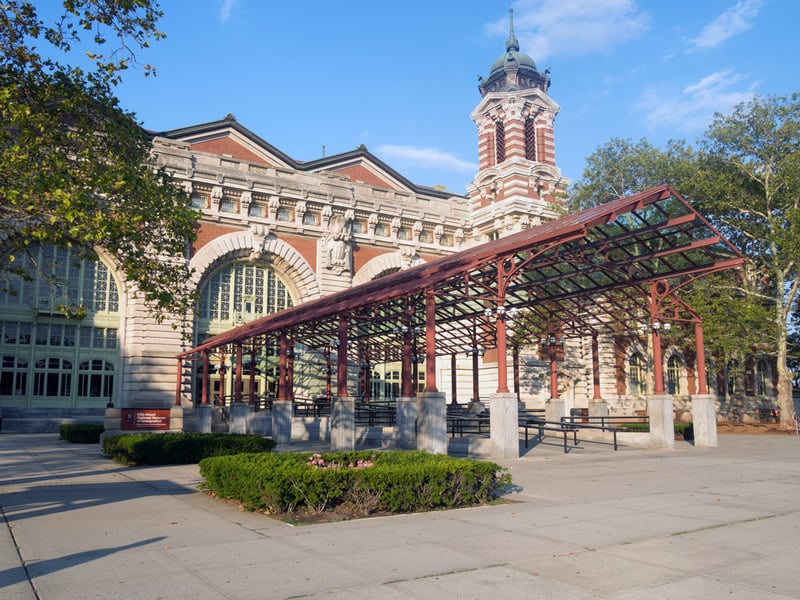
Ellis Island National Monument
The Ellis Island historical site holds a special place in the history of immigrants. Now quiet halls, the national monument acted as a hallway where millions of immigrants passed between 1892 and 1954 to attain the American dream. Millions of Americans can claim to have their ancestors pass-through this island.
The site also acted as the federal immigration station in the late 19th century, with millions of immigrants using the Island when coming to the colony. Federal officials were centered at the site to inspect immigrants before allowing them into the country.
Most immigrants who passed through to the country were treated respectfully. Increased restrictions were only placed after the First World War with regulations such as literacy tests.
The building underwent a massive restoration with the main building transformed into a museum dedicated to immigration history.
When you visit the monument, you will be taken through the important role that Ellis Island played during humanity’s mass migration to the United States. It was declared as part of the Statue of Liberty monument in 1965 before reopening to the public in 1990 after restoration.
Things to do:
- Visit the Ellis Island National Museum of Immigration
- Listen to an audio tour
- Watch the film “Island of Hope, Island of Tears”
- Stop by the gift shop
*National Parks of New York Harbor
New York’s architecture has been vital to the iconic nature of the city. The city is filled with buildings of all shapes and sizes, with the history of New York traced through the different styles of architecture.
The National Parks of New York Harbor describe the national park service office that deals with coordinating the administration of the NPS sites. These include 23 unique destinations within the New York metropolitan area. However, despite the name, the office does not oversee any National Parks here as it focuses on National Monuments and Historic Sites.
African Burial Ground National Monument
This is the largest known excavated burial ground for slaves in North America and one of the oldest burial grounds. The discovery of this historical site extends to the Dutch settlement’s beginnings, with the Dutch viewing slavery in a more transient manner. The colony of New York has more slaves than any other colonies, with slavery playing an important role in developing the colony as a major port city.
This burial ground was the final resting place for over 15000 slaves before it was lost under urban development years. However, it was rediscovered in 1991 during the excavation of the land that revealed several individual artifacts’ remains. The site is considered one of the most important archeological finds of the 20th century, thus having national significance. The story about the lives of African Americans in an urban context is worth telling.
This burial ground has a landmark status protection after being designated a New York City landmark in 1993. The landmark was then designated a national historic monument in 2006. There is also a bronze sculpture within the site inspired by individuals removed from the burial ground.
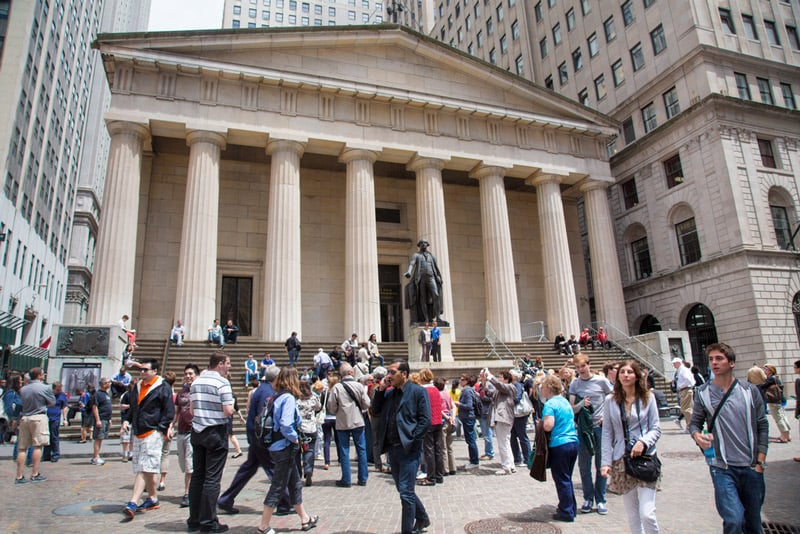
Federal Hall National Memorial
This site was a national treasure as the home to the first congress, Supreme Court, and other important events. As such, it is one of the most significant landmarks in America where the first president took an oath. While this historic building is often overlooked and overshadowed, much of American history took place inside this building’s walls. For example, the Bill of Rights was proposed and ratified in the Federal Hall and hosted the creation of the federal court system in the country.
Today, the Federal Hall is not the original building as it was demolished to make way for the current City Hall. The current Federal Hall building was given national memorial status in 1955, and the inside transformed to be a museum dedicated to the first US president. There is a statue of George Washington on the building steps in the same location where George Washington stood while taking office.
This is a historic building found in Manhattan’s financial district right in the center of Wall Street. The center was crucial in the early years of American independence with many American events occurring at the building.
Between 1862 and 1920, the Federal Hall National Memorial was one of the six federal treasury buildings storing millions of worth of precious metals. However, the gold and silver inside this building were moved to the Federal Reserve Bank, leaving exhibits off the US constitution, the federal government, and the first US president. Today, the memorial houses a museum on Washington’s administration, including the bible used during his inauguration.
Gateway National Recreation Area
This National Recreation Area is a large and diverse urban park comprising over 26000 acres of coastal uplands, freshwater ponds, and bay. Mudflats and marshes. It is a pioneering example of large-scale ecological reclamation of land within an urban setting.
Gateway National Recreation Area was established in 1972 as part of the strategic effort to create more national parks near urban centers. As such, it serves the purpose of recreational and leisure as opposed to being a sole tourist destination.
This recreational area has a great diversity of ecological, historical, scenic, and recreational resources that offer many opportunities for New York people.
Stonewall National Monument
This is one of the important monuments representing the LGBT community. It was the 412th unit of the National Park System located in Christopher Park. The Civil rights events of June 1969 in Stonewall played a role in shaping the modern LGBTQ civil rights movements. As such, this was the beginning of the LGBT rights movement in the United States.
Crowds within the Stonewall Inn held their ground in demanding civil rights with the protests expanding into the park. The gay New Yorkers demanded that they live their lives free of violence and discrimination.
The Stonewall National Monument was designated in 2016 as the first monument chosen for its LGBT history. As such, this historic moment increased universal attention to the village site that transformed LGBT lives. Its creation is a great success for the LGBT community.
Hence, this national monument protects Christopher Park sitting on a seven-acre site. It now offers visitors a chance to learn about the LGBT community’s history in the country. The tours and historical panels in the area, such as the rainbow flag raised at the monument, make it the first LGBT flag at a federal monument.
Things to do:
- Explore Greenwich Village on an LGBT History walking tour
Castle Clinton National Monument
The Castle Clinton represents the growth of New York City, having been the first site where the city began. It is located at the southern tip of Manhattan Island within Battery Park and two blocks west of where Fort Amsterdam was built.
At the time of its construction, the Castle Clinton was intended to complement the three-tier Castle Williams. The monument was a venue for art, culture, and science for visitors in the late 19th century. It is filled with stories of new beginnings, innovation, and survival while serving as a physical reminder of New York City history.
This park is best known as one of the pioneer immigration stations where millions of people arrived in the US between 1855 and 1890. The immigrant landing depot in 1855 was functioning as the immigrant processing center for the New York state. Today, the monument plays a crucial role in helping people reach the Statue of Liberty or Ellis Island.
The national monument has also functioned as an exhibition hall, theater, beer garden, and aquarium. For example, it was one of the most popular attractions in the city when acting as an aquarium. The structure was rehabilitated over the years where it was roofed over to a height of several stories. However, its original masonry fort still stands and remains a national monument.
As the United States has been welcoming immigrants from all over the world, the Castle garden was refurbished into the official emigrant landing depot that allowed processing immigrants before entering the country. Almost two-thirds of immigrants between 1855 and 1890 passed through the Castle Clinton before settling in other areas.
The petition to preserve the Castle Clinton began after the Second World War and was declared a national monument in 1946. The National Park service then restored it by 1975. This building has served many roles throughout New York’s storied history. For centuries, the building has been used for entertainment, protection, and a new life in America. Today, the monument serves as the departure point for anyone visiting the Statue of Liberty.
Things to do:
- 20-minute guided tour of the castle
Saint Paul’s Church National Historic Site
This 18th century church has played a crucial role in Eastchester’s life since 1665. This is one of the oldest churches in Mount Vernon, New York. At one point, it acted as a makeshift hospital during the American revolutionary war and the scene for ma military developments afterward. It remained a worship place until the late 1970s when a declining congregation forced it to discontinue the services.
It is an example of Georgia architecture that remains a national treasure. The site is home to the Liberty bell’s twin that houses in New York, America. The church’s interior was restored in part of the efforts to try and increase its historical significance. The initial purpose of restoration was to revive the congregation, but this could not last with the last regular Sunday service at the parish held in May 1977.
The church was gifted to the National Park Service in 1980, where it was officially designated a national historic site. It was then transferred to the National Park Service from the Episcopal Diocese of New York.
In essence, this church has a two-fold claim to historic fame. Firstly, it is the only surviving colonial church in the city of New York. Secondly, the site where Saint Paul’s Church stands is associated with the fight for freedom. It contains history to the First Amendment that guarantees the press’s freedom due to the Zenger trial. In essence, this 18th-century played a role in starting the freedom of press and religion.
At the same time, this church contains an altarpiece by the same architect who designed Washington DC. Some of this historic church include a list of pew-holders with their locations, period illustrations, and church photographs. Collections within the Saint Paul’s Church are major tourist attractions.
Things to do:
- Explore the 250-year-old church
- Take a 1.5-hour ranger-led tour
- Listen to the sounds of an 1830 pipe organ
- Tour the historic cemetery
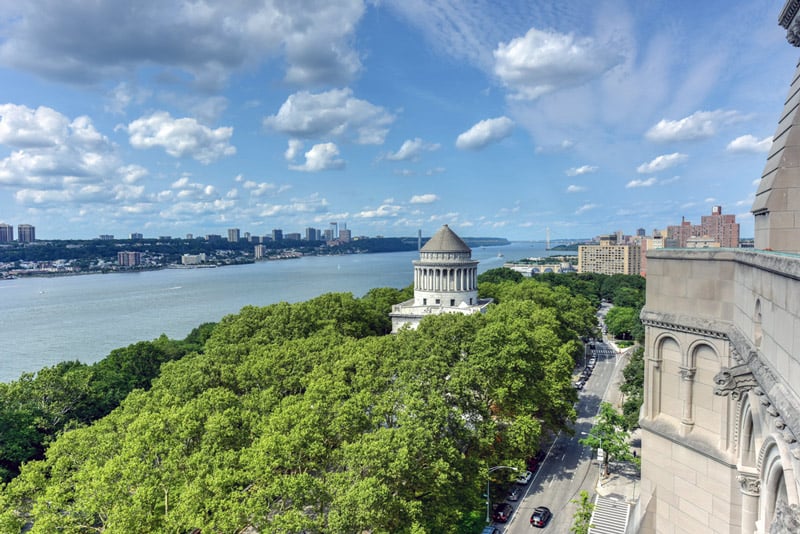
Governors Island National Monument
Governors Island is located just south of Manhattan where the East and Hudson Rivers join together. This national monument is the site of what was for over two centuries a military base.
In 1996, the island’s fortifications and base were closed as a Coast Guard establishment. The island was then sold to the city and state of New York to become a site devoted to public benefit. This is when the site was converted into a park.
The National Trust for Historic Preservation took over ownership of the island in 2003. It was converted to a national monument. These days, visitors can tour 22 acres of the island and view the remains of Castle Williams and other preserved fortifications on the island.
Governor’s Island is open for tours for members of the public from May through October. Visitors can tour Castle Williams and Fort Jay. They can also enjoy views of the Manhattan skyline. In addition to serving as a historical landmark, Governor’s Island is also a venue for artistic and cultural events.
Theodore Roosevelt Birthplace
The Theodore Roosevelt Birthplace is located in Manhattan’s Flatiron District. It is found on East 20th Street between Park and Broadway. The building itself is a brownstone that was initially constructed in the mid 19th century. Although the original building was demolished in 1916, the lot on which it was built was bought by the Women’s Roosevelt Memorial Association after Theodore Roosevelt died. At this point, a replica of the original house was rebuilt.
In 1963, the building was turned over to the ownership of the National Park Service. At this point, the Theodore Roosevelt Birthplace was made a National Historical Site. Those who visit the Theodore Roosevelt Birthplace can learn about the life of the 26th president of the United States. They can view the surroundings in which young Roosevelt was born and spent the early part of his life. They can also gain an understanding of what this part of New York City environment was like in the mid 19th century when Roosevelt was born.
There are many exhibits that can be viewed at the Theodore Roosevelt Birthplace. Rooms within the building have been restored to their appearance at the time of Roosevelt’s birth. There are also exhibits explaining the recreation of the building after it was demolished in the early 20th century and later rebuilt.
Hamilton Grange National Memorial
The Hamilton Grange National Memorial is a National Historical Site of the the home of Alexander Hamilton, one of the founding fathers. The Hamilton Grange National Memorial is located in Harlem at 414 West 141st Street. Hamilton lived in this home for only two years from 1802 until his death in 1804. Hamilton Grange is the only property that Hamilton ever owned. The property stayed in Hamilton’s family around three decades after he was killed in a duel with Aaron Burr in 1804.
Hamilton Grange National Memorial was designated a National Historical Landmark in 1960. It was soon thereafter added to the National Register of Historic Places in 1966. These days, those who visit Hamilton Grange can view restorations of the building’s interior and learn about Alexander Hamilton’s life. They can also look at historical photos of the building and gain an understanding of what this part of Upper Manhattan was like during Alexander Hamilton’s time.
Visitor’s can take part in guided tours of Hamilton Grange and tour the grounds. The entire National Historic Landmark includes landscaped grounds with 13 sweet gum trees, a rose garden, and a stone wall similar to those which existed on the grounds of the original Hamilton Grange during Hamilton’s time.
General Grant National Memorial
The General Grant National Memorial is the place where Ulysses S. Grant, the 18th president of the United States, is buried. The tomb is located in the Morningside Heights area of upper Manhattan. The tomb is found near the intersection of Riverside Drive and West 122nd Street. This tomb has been accessible for tours to members of the public since 1958. It was placed on the list of the National Register of Historic Places in 1966.
It is free to visit the General Grant National Memorial. The memorial site includes both a mausoleum and a visitor center. The site also includes an exhibit gallery, a book store, and a gift shop. There is a media room that’s part of the site where visitors can view a film entitled Ulysses S. Grant – A Legacy of Freedom.
National Parks in New York
While New York is not necessarily known for it’s National Park, the historic sites and monuments are some of the most important and influential in the US. It’s worth taking a visit to New York, even if you’re looking to stay within the city and visit the parks of New York Harbor.
National Parks In The Surrounding Area
- National Parks in Delaware
- National Parks in New Jersey
- National Parks in Pennsylvania
- National Parks in Maryland
- National Parks in Connecticut
- National Parks in Massachusetts
- National Parks in Rhode Island
- National Parks in New Hampshire
- National Parks in Vermont
Wanna Get Away?
Try glamping: In a nearby treehouse rental in New York